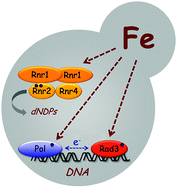The elemental role of iron in DNA synthesis and repair
Abstract
Iron is an essential redox element that functions as a cofactor in many metabolic pathways. Critical enzymes in DNA metabolism, including multiple DNA repair enzymes (helicases, nucleases, glycosylases, demethylases) and ribonucleotide reductase, use iron as an indispensable cofactor to function. Recent striking results have revealed that the catalytic subunit of DNA polymerases also contains conserved cysteine-rich motifs that bind iron–sulfur (Fe/S) clusters that are essential for the formation of stable and active complexes. In line with this, mitochondrial and cytoplasmic defects in Fe/S cluster biogenesis and insertion into the nuclear iron-requiring enzymes involved in DNA synthesis and repair lead to DNA damage and genome instability. Recent studies have shown that yeast cells possess multi-layered mechanisms that regulate the ribonucleotide reductase function in response to fluctuations in iron bioavailability to maintain optimal deoxyribonucleotide concentrations. Finally, a fascinating DNA charge transport model indicates how the redox active Fe/S centers present in DNA repair machinery components are critical for detecting and repairing DNA mismatches along the genome by long-range charge transfers through double-stranded DNA. These unexpected connections between iron and DNA replication and repair have to be considered to properly understand cancer, aging and other DNA-related diseases.

- This article is part of the themed collections: Recent Review Articles and Iron in Biology


 Please wait while we load your content...
Please wait while we load your content...